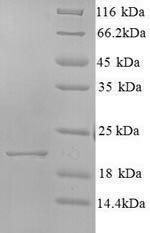Background
Core protein packages viral RNA to form a viral nucleocapsid, and promotes virion budding. Modulates viral translation initiation by interacting with HCV IRES and 40S ribosomal subunit. Also regulates many host cellular functions such as signaling pathways and apoptosis. Prevents the establishment of cellular antiviral state by blocking the interferon-alpha/beta (IFN-alpha/beta) and IFN-gamma signaling pathways and by inducing human STAT1 degradation. Thought to play a role in virus-mediated cell transformation leading to hepatocellular carcinomas. Interacts with, and activates STAT3 leading to cellular transformation. May repress the promoter of p53, and sequester CREB3 and SP110 isoform 3/Sp110b in the cytoplasm. Also represses cell cycle negative regulating factor CDKN1A, thereby interrupting an important check point of normal cell cycle regulation. Targets transcription factors involved in the regulation of inflammatory responses and in the immune response: suppresses NK-kappaB activation, and activates AP-1. Could mediate apoptotic pathways through association with TNF-type receptors TNFRSF1A and LTBR, although its effect on death receptor-induced apoptosis rains controversial. Enhances TRAIL mediated apoptosis, suggesting that it might play a role in immune-mediated liver cell injury. Seric core protein is able to bind C1QR1 at the T-cell surface, resulting in down-regulation of T-lymphocytes proliferation. May transactivate human MYC, Rous sarcoma virus LTR, and SV40 promoters. May suppress the human FOS and HIV-1 LTR activity. Alters lipid metabolism by interacting with hepatocellular proteins involved in lipid accumulation and storage. Core protein induces up-regulation of FAS promoter activity, and thereby probably contributes to the increased triglyceride accumulation in hepatocytes (steatosis) .E1 and E2 glycoproteins form a heterodimer that is involved in virus attachment to the host cell, virion internalization through clathrin-dependent endocytosis and fusion with host mbrane. E1/E2 heterodimer binds to human LDLR, CD81 and SCARB1/SR-BI receptors, but this binding is not sufficient for infection, some additional liver specific cofactors may be needed. The fusion function may possibly be carried by E1. E2 inhibits human EIF2AK2/PKR activation, preventing the establishment of an antiviral state. E2 is a viral ligand for CD209/DC-SIGN and CLEC4M/DC-SIGNR, which are respectively found on dendritic cells (DCs), and on liver sinusoidal endothelial cells and macrophage-like cells of lymph node sinuses. These interactions allow capture of circulating HCV particles by these cells and subsequent transmission to permissive cells. DCs act as sentinels in various tissues where they entrap pathogens and convey th to local lymphoid tissue or lymph node for establishment of immunity. Capture of circulating HCV particles by these SIGN+ cells may facilitate virus infection of proximal hepatocytes and lymphocyte subpopulations and may be essential for the establishment of persistent infection .P7 ses to be a heptameric ion channel protein (viroporin) and is inhibited by the antiviral drug amantadine. Also inhibited by long-alkyl-chain iminosugar derivatives. Essential for infectivity .Protease NS2-3 is a cysteine protease responsible for the autocatalytic cleavage of NS2-NS3. Ses to undergo self-inactivation following maturation .NS3 displays three enzymatic activities: serine protease, NTPase and RNA helicase. NS3 serine protease, in association with NS4A, is responsible for the cleavages of NS3-NS4A, NS4A-NS4B, NS4B-NS5A and NS5A-NS5B. NS3/NS4A complex also prevents phosphorylation of human IRF3, thus preventing the establishment of dsRNA induced antiviral state. NS3 RNA helicase binds to RNA and unwinds dsRNA in the 3' to 5' direction, and likely RNA stable secondary structure in the tplate strand. Cleaves and inhibits the host antiviral protein MAVS .NS4B induces a specific mbrane alteration that serves as a scaffold for the virus replication complex. This mbrane alteration gives rise to the so-called ER-derived mbranous web that contains the replication complex .NS5A is a component of the replication complex involved in RNA-binding. Its interaction with Human VAPB may target the viral replication complex to vesicles. Down-regulates viral IRES translation initiation. Mediates interferon resistance, presumably by interacting with and inhibiting human EIF2AK2/PKR. Ses to inhibit apoptosis by interacting with BIN1 and FKBP8. The hyperphosphorylated form of NS5A is an inhibitor of viral replication .NS5B is an RNA-dependent RNA polymerase that plays an essential role in the virus replication.
Regerences
An RNA-binding protein, hnRNP A1, and a scaffold protein, septin 6, facilitate hepatitis C virus replication.Kim C.S., Seol S.K., Song O.-K., Park J.H., Jang S.K.J. Virol. 81:3852-3865(2007)
